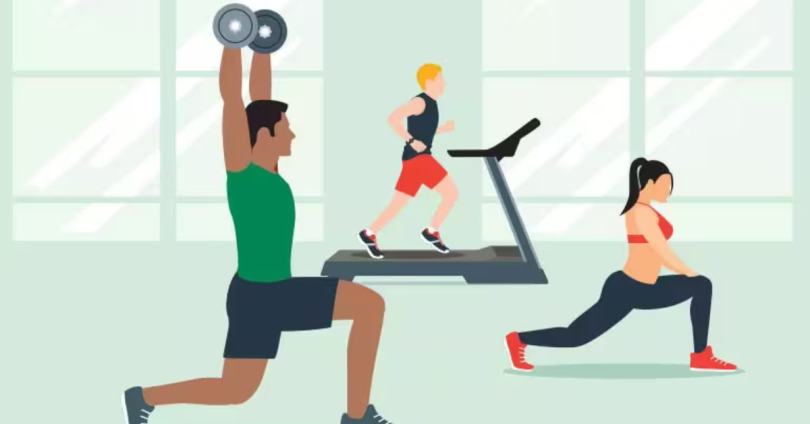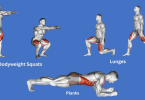Introduction
The Challenge of Staying Fit with a Busy Schedule
In today’s fast-paced world, finding time to exercise can feel nearly impossible. Between work, family, and daily responsibilities, fitness often ends up at the bottom of the to-do list. However, staying active doesn’t have to mean spending hours at the gym. With a smart approach and a bit of consistency, you can maintain a healthy lifestyle — even with a packed schedule.
The Importance of Short, Consistent Workouts
The key to lasting fitness success isn’t long, intense sessions — it’s consistency. Short, focused workouts done regularly can be just as effective as longer ones. Even 15–30 minutes a day can boost your metabolism, improve energy, and strengthen your body. The goal is to move daily, build habits, and make exercise a natural part of your routine.
Benefits of Following a Daily Fitness Plan
A structured daily plan keeps you accountable and ensures you’re progressing over time. By following a consistent schedule:
- You develop discipline and momentum.
- You enhance your overall fitness and mental clarity.
- You reduce stress and increase daily energy levels.
With a clear routine, you no longer have to “find time” to work out — it simply becomes part of your lifestyle.
Why Busy People Struggle with Fitness

Lack of Time and Motivation
One of the biggest challenges for busy individuals is simply finding the time to work out. Between deadlines, family commitments, and daily errands, it can feel like there’s no room for exercise. On top of that, fatigue and stress can drain motivation, making it easy to skip workouts — especially after a long day.
However, even short bursts of movement can make a meaningful difference when done consistently.
Long Working Hours and Sedentary Jobs
Modern work life often involves long hours sitting at a desk or in front of a screen. This sedentary lifestyle can lead to stiffness, poor posture, and decreased energy levels. Over time, inactivity contributes to weight gain, muscle loss, and reduced mobility.
Incorporating simple exercises or stretch breaks throughout the day helps combat these effects and keeps your body active.
Common Excuses That Prevent Consistency
Many people believe they need an hour, a gym membership, or the perfect conditions to exercise — but these are often just mental barriers. Common excuses like “I’m too tired,” “I don’t have equipment,” or “I’ll start next week” delay progress and break momentum.
Shifting your mindset to focus on progress over perfection helps overcome these barriers and builds lasting habits.
How Small Changes Can Make a Big Difference
You don’t need a massive overhaul to improve your fitness — just small, intentional steps each day. Even 10–20 minutes of daily movement, walking more, or doing quick bodyweight exercises can have powerful effects on your health, energy, and mindset.
The key is to start small, stay consistent, and remem
Benefits of a Daily Fitness Routine

Boosts Energy and Focus
Regular movement increases blood flow and oxygen to your muscles and brain, leaving you feeling more alert and productive throughout the day. Even a short workout can shake off fatigue and mental fog, helping you perform better at work, school, or home.
Exercise isn’t just about fitness — it’s one of the best natural energy boosters.
Improves Physical Strength and Flexibility
Daily workouts strengthen your muscles, improve joint mobility, and enhance flexibility. This not only supports better posture and coordination but also makes everyday activities — like carrying groceries or climbing stairs — easier and more efficient.
Strength and flexibility are key to maintaining a healthy, active lifestyle as you age.
Reduces Stress and Improves Mental Health
Exercise releases endorphins, your body’s natural “feel-good” chemicals, which help combat stress, anxiety, and depression. Regular movement provides a healthy outlet for tension and boosts your mood.
Taking even 20 minutes for yourself each day can make a big difference in how you feel mentally and emotionally.
Helps Manage Weight and Posture
Consistent physical activity helps regulate metabolism and supports healthy weight management. It also strengthens your core and back muscles, improving posture — especially important for those with desk jobs or sedentary routines.
Better posture means less strain on your body and more confidence in your stance.
Builds Lifelong Healthy Habits
Committing to daily movement encourages discipline, consistency, and self-care. Over time, it shifts your mindset from “I have to work out” to “I want to move my body.” These small daily efforts add up to lasting habits that support long-term health and well-being.
Fitness becomes not just a goal — but a lifestyle.
Benefits of a Daily Fitness Routine
Boosts Energy and Focus
Regular movement increases blood flow and oxygen to your muscles and brain, leaving you feeling more alert and productive throughout the day. Even a short workout can shake off fatigue and mental fog, helping you perform better at work, school, or home.
Exercise isn’t just about fitness — it’s one of the best natural energy boosters.
Improves Physical Strength and Flexibility
Daily workouts strengthen your muscles, improve joint mobility, and enhance flexibility. This not only supports better posture and coordination but also makes everyday activities — like carrying groceries or climbing stairs — easier and more efficient.
Strength and flexibility are key to maintaining a healthy, active lifestyle as you age.
Reduces Stress and Improves Mental Health
Exercise releases endorphins, your body’s natural “feel-good” chemicals, which help combat stress, anxiety, and depression. Regular movement provides a healthy outlet for tension and boosts your mood.
Taking even 20 minutes for yourself each day can make a big difference in how you feel mentally and emotionally.
Helps Manage Weight and Posture
Consistent physical activity helps regulate metabolism and supports healthy weight management. It also strengthens your core and back muscles, improving posture — especially important for those with desk jobs or sedentary routines.
Better posture means less strain on your body and more confidence in your stance.
Builds Lifelong Healthy Habits
Committing to daily movement encourages discipline, consistency, and self-care. Over time, it shifts your mindset from “I have to work out” to “I want to move my body.” These small daily efforts add up to lasting habits that support long-term health and well-being.
Fitness becomes not just a goal — but a lifestyle.
How to Plan Your Daily Fitness Routine
Identify Your Best Workout Time (Morning or Evening)
The best time to work out is the time that fits your lifestyle and energy levels.
- Morning workouts can boost your metabolism, improve focus, and set a positive tone for the day.
- Evening workouts help release stress, unwind, and can be more convenient after work hours.
Experiment with both and find what works best for you — consistency matters more than timing.
When you schedule your workouts around your natural rhythm, you’re more likely to stick with them.
Choose Short and Efficient Workouts (15–30 Minutes)
You don’t need long sessions to see results. Focus on short, high-quality workouts that engage multiple muscle groups and keep your heart rate up.
Examples include:
- 20-minute full-body circuits
- 15-minute HIIT (High-Intensity Interval Training) sessions
- Quick yoga or stretching routines for flexibility
Even a brief, focused workout is far better than none — it’s all about showing up consistently.
Mix Cardio, Strength, and Stretching Exercises
A balanced routine includes all three components for optimal results:
- Cardio (like jogging in place, jumping jacks, or brisk walking) boosts endurance and heart health.
- Strength training (such as push-ups, squats, or lunges) builds muscle and supports posture.
- Stretching or mobility work improves flexibility, reduces stiffness, and enhances recovery.
Variety keeps your workouts fun, effective, and sustainable.
Schedule Workouts Like Appointments
Treat your workouts as non-negotiable appointments with yourself. Block out time on your calendar or set reminders — just as you would for meetings or calls.
- Plan specific days and times for workouts.
- Prepare your clothes or space in advance.
- Stick to your plan even on busy days, even if it means doing a shorter session.
Making exercise a priority turns it from a task into a daily habit.
Quick Warm-Up Routine (3–5 Minutes)
The Importance of Warming Up
Before diving into your workout, take a few minutes to warm up your body. A proper warm-up increases blood flow, loosens your joints, and prepares your muscles for movement. It also reduces the risk of injury and helps you perform better during your workout.
Even just 3–5 minutes of warm-up can make a big difference in how your body feels and moves.
Simple Warm-Up Exercises
Jumping Jacks
A classic full-body move that raises your heart rate and activates your muscles. Perform for 30–60 seconds to get your body energized.
Arm Circles
Extend your arms to the sides and make small circular motions, gradually increasing the size of the circles. This loosens your shoulders and prepares your upper body for exercise.
High Knees
Jog in place while lifting your knees toward your chest. This move engages your core, warms up your legs, and gets your heart pumping.
Torso Twists
Stand tall with feet hip-width apart and twist your torso side to side, letting your arms move naturally. This helps warm up your spine and core muscles, improving flexibility and range of motion.
Keep your movements light and controlled. The goal is to awaken your body — not exhaust it — so you’re ready to move efficiently and safely in your main workout.
Daily 20-Minute Workout Plan
How It Works
This 6-day schedule offers a balanced mix of strength, cardio, and flexibility — all in just 20 minutes a day. Each session focuses on different muscle groups to keep your routine effective, engaging, and easy to maintain. You’ll build strength, improve endurance, and boost overall energy — no gym required.
Monday: Full Body Strength
Focus on compound bodyweight exercises that target multiple muscle groups.
Example Routine:
- Squats – 12–15 reps
- Push-ups – 10–12 reps
- Lunges – 10 reps per leg
- Plank – 30 seconds
- Repeat circuit 2–3 times
This session builds total-body strength and activates your core.
Tuesday: Cardio & Core
Boost your heart rate while engaging your abs and obliques.
Example Routine:
- Jumping jacks – 1 minute
- Mountain climbers – 30 seconds
- Bicycle crunches – 15 reps per side
- High knees – 1 minute
- Plank with shoulder taps – 30 seconds
- Repeat 2–3 rounds
Perfect for improving endurance and core stability.
Wednesday: Lower Body
Strengthen and tone your legs and glutes with controlled, lower-body moves.
Example Routine:
- Squats – 15 reps
- Glute bridges – 12–15 reps
- Reverse lunges – 10 reps per leg
- Calf raises – 15 reps
- Wall sit – 30 seconds
- Repeat 2–3 rounds
Lower body strength supports better posture and mobility.
Thursday: Upper Body & Core
Target your arms, shoulders, chest, and abs for balanced upper-body strength.
Example Routine:
- Push-ups – 10–12 reps
- Tricep dips (using a chair) – 10–12 reps
- Superman hold – 30 seconds
- Side plank – 20 seconds per side
- Plank shoulder taps – 30 seconds
- Repeat 2–3 rounds
Strong upper body muscles support daily movements and improve core stability.
Friday: Cardio Burn
End the week strong with a fat-burning, high-energy workout.
Example Routine:
- Jump squats – 30 seconds
- Skater hops – 30 seconds
- Burpees – 30 seconds
- High knees – 1 minute
- Mountain climbers – 30 seconds
- Repeat 2–3 rounds
This session elevates your heart rate and boosts endurance.
Weekend: Light Yoga or Stretching
Take time to recover and relax while maintaining gentle movement.
Example Routine:
- Forward fold stretch – 30 seconds
- Cat-cow stretch – 1 minute
- Child’s pose – 30 seconds
- Seated spinal twist – 30 seconds each side
- Deep breathing – 1 minute
Active recovery keeps your muscles flexible and prepares you for the next week.
Daily 20-Minute Workout Plan
Overview
This 20-minute daily workout plan is perfect for busy individuals who want to stay fit without spending hours at the gym. Each day focuses on a different muscle group or training style to promote balance, strength, and endurance — while keeping your routine short, simple, and sustainable.
Monday: Full Body Strength
Engage all major muscle groups to build strength and stability.
Example Exercises:
- Bodyweight squats – 15 reps
- Push-ups – 10–12 reps
- Lunges – 10 reps per leg
- Plank – 30 seconds
- Repeat for 2–3 rounds
This session boosts overall body strength and core control.
Tuesday: Cardio & Core
Raise your heart rate and strengthen your abs for better endurance and stability.
Example Exercises:
- Jumping jacks – 1 minute
- Mountain climbers – 30 seconds
- Bicycle crunches – 15 reps per side
- High knees – 1 minute
- Plank with shoulder taps – 30 seconds
- Repeat for 2–3 rounds
This routine enhances stamina and tones your midsection.
Wednesday: Lower Body
Target your legs and glutes with exercises that improve power and balance.
Example Exercises:
- Squats – 15 reps
- Glute bridges – 12–15 reps
- Reverse lunges – 10 reps per leg
- Calf raises – 15 reps
- Wall sit – 30 seconds
- Repeat for 2–3 rounds
Building lower-body strength supports posture and daily movement.
Thursday: Upper Body & Core
Focus on your arms, shoulders, chest, and abs to build strength and stability.
Example Exercises:
- Push-ups – 10–12 reps
- Tricep dips (using a chair) – 10–12 reps
- Superman hold – 30 seconds
- Side plank – 20 seconds per side
- Plank shoulder taps – 30 seconds
- Repeat for 2–3 rounds
This workout sculpts your upper body and strengthens your core.
Friday: Cardio Burn
End your week with a heart-pumping workout to burn calories and boost endurance.
Example Exercises:
- Jump squats – 30 seconds
- Skater hops – 30 seconds
- Burpees – 30 seconds
- High knees – 1 minute
- Mountain climbers – 30 seconds
- Repeat for 2–3 rounds
Great for improving cardiovascular fitness and overall stamina.
you may also like to read these posts:
Discover the Beauty of Indonesian Traditional Fashion Styles
Learn Java Easily Online with Simple Coding Examples
Easy Core Java Tutorials for Beginners to Start Coding
Beginner-Friendly Home Workouts: Simple Routines to Get Started
Weekend: Light Yoga or Stretching
Use your weekend to recover, relax, and restore flexibility.
Example Routine:
- Forward fold stretch – 30 seconds
- Cat-cow stretch – 1 minute
- Child’s pose – 30 seconds
- Seated spinal twist – 30 seconds per side
- Deep breathing – 1 minute
Active recovery keeps your body loose, flexible, and ready for the week ahead.
No-Equipment Exercises for Busy People
Overview
You don’t need a gym or special equipment to get an effective workout. These simple bodyweight exercises can be done anywhere — at home, in your office, or even during travel. They target multiple muscle groups, improve endurance, and help you stay active no matter how busy your schedule is.
1. Squats
Squats strengthen your legs, glutes, and core while improving balance and mobility.
How to Do It: Stand with feet shoulder-width apart, lower your hips as if sitting into a chair, then push through your heels to return to standing.
Tip: Keep your chest lifted and knees aligned with your toes.
Benefit: Builds lower-body strength and supports better posture.
2. Push-Ups
Push-ups work your chest, shoulders, triceps, and core, making them a perfect upper-body move.
How to Do It: Begin in a plank position with hands slightly wider than shoulders. Lower your chest toward the floor, then push back up.
Modification: Perform on your knees or against a wall if needed.
Benefit: Strengthens upper body and core simultaneously.
3. Lunges
Lunges improve leg strength, coordination, and balance while targeting the glutes and thighs.
How to Do It: Step forward with one leg, lower your back knee toward the floor, then push through your front heel to return to standing. Alternate legs.
Tip: Keep your front knee over your ankle to maintain good form.
Benefit: Enhances stability and tones the lower body.
4. Plank
The plank is one of the best exercises for core strength and overall stability.
How to Do It: Hold your body in a straight line from head to heels, supporting yourself on your forearms or hands. Engage your core and avoid sagging hips.
Variation: Try side planks or plank shoulder taps for an extra challenge.
Benefit: Builds core endurance and supports better posture.
5. Mountain Climbers
A dynamic exercise that combines cardio and core work.
How to Do It: Start in a plank position and alternate driving your knees toward your chest in a quick, running motion.
Tip: Keep your hips low and move smoothly to maintain rhythm.
Benefit: Improves cardiovascular health and total-body coordination.
6. Burpees
Burpees are a full-body movement that builds strength and boosts heart rate.
How to Do It: From a standing position, squat down, place your hands on the floor, jump your feet back into a plank, then jump forward and leap upward with your arms overhead.
Modification: Step back instead of jumping to reduce impact.
Benefit: Increases endurance, burns calories, and improves overall fitness.
Nutrition & Lifestyle Tips
Overview
Exercise is only one part of a healthy lifestyle — your nutrition, hydration, sleep, and recovery habits play equally important roles. Making small, smart choices in these areas can greatly enhance your workout results and overall well-being.
Meal Prep and Healthy Snacking
Plan Ahead for Success
Meal prepping helps you avoid unhealthy, last-minute food choices. Set aside time each week to prepare balanced meals rich in lean proteins, whole grains, fruits, and vegetables.
Smart Snack Ideas
Keep healthy snacks like nuts, yogurt, fruit, or veggie sticks on hand to maintain steady energy throughout the day.
Tip: Pair protein and fiber (e.g., apple slices with peanut butter) to stay full longer.
Benefit: Consistent nutrition supports muscle recovery and steady energy levels.
Staying Hydrated
Why Hydration Matters
Water is essential for digestion, circulation, and muscle function. Even mild dehydration can cause fatigue and affect performance.
How Much to Drink
Aim for 6–8 glasses of water per day, and increase your intake when exercising or during hot weather. Herbal teas, infused water, and electrolyte drinks can also help.
Benefit: Staying hydrated improves energy, focus, and recovery.
Managing Sleep and Recovery
Prioritize Rest
Your body repairs and strengthens itself during sleep. Aim for 7–9 hours of quality sleep each night to support recovery and energy levels.
Active Recovery
Incorporate light activities like stretching, yoga, or walking on rest days. This improves circulation and reduces muscle soreness.
Benefit: Proper recovery prevents burnout and supports long-term consistency.
Balancing Diet with Workout Intensity
Fuel for Your Goals
Your diet should match your activity level. Eat balanced meals with carbohydrates for energy, protein for muscle repair, and healthy fats for endurance.
Before & After Workouts
- Pre-workout: A light snack like a banana or oatmeal gives you energy.
- Post-workout: Refuel with protein (eggs, yogurt, smoothie) to aid muscle recovery.
Benefit: Eating smart around workouts maximizes results and maintains energy balance.
Faqs:
How much time should I spend exercising each day if I’m busy?
Even 15–30 minutes a day is enough to stay fit and healthy. A short, consistent routine is more effective than long workouts done irregularly.
Can I follow this daily fitness plan at home or in the office?
Yes! This daily fitness plan for busy people can be done anywhere — at home, in your office, or even during short breaks. Most exercises require no equipment.
What is the best time of day to exercise for busy people?
The best time is whenever you can be consistent — whether it’s early morning, lunch break, or evening. Choose a time that fits your schedule and energy levels.
Will a 20-minute workout really make a difference?
Absolutely! A focused 20-minute workout combining strength, cardio, and stretching can help you burn fat, build muscle, and increase energy throughout the day.
How can I stay motivated to work out with a busy schedule?
Set realistic goals, plan workouts like meetings, and track your progress. Even small daily wins will keep you motivated to stick with your daily fitness plan for busy people.
Conclusion
A daily fitness plan for busy people proves that staying healthy doesn’t require hours in the gym — just consistency and smart planning. With short, effective workouts, you can boost your energy, manage stress, and maintain a fit body even on the busiest days. Remember, fitness is about progress, not perfection. Start with a few minutes each day, stay committed, and soon your small efforts will lead to big, lasting results.




